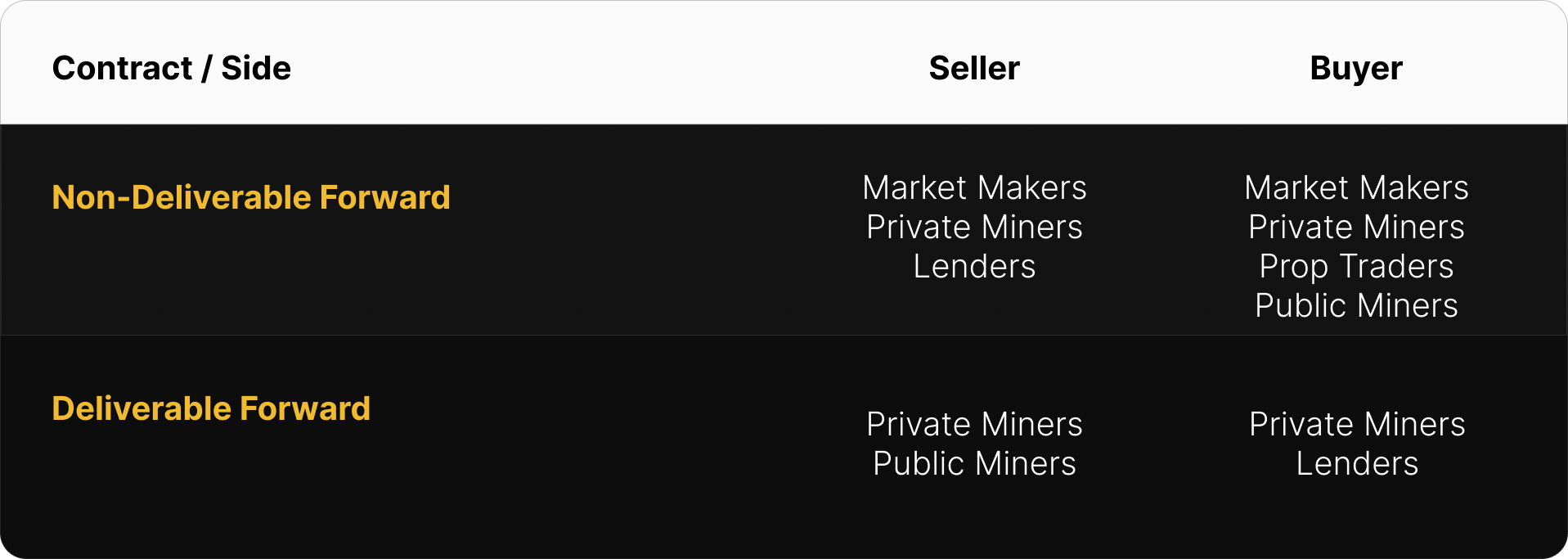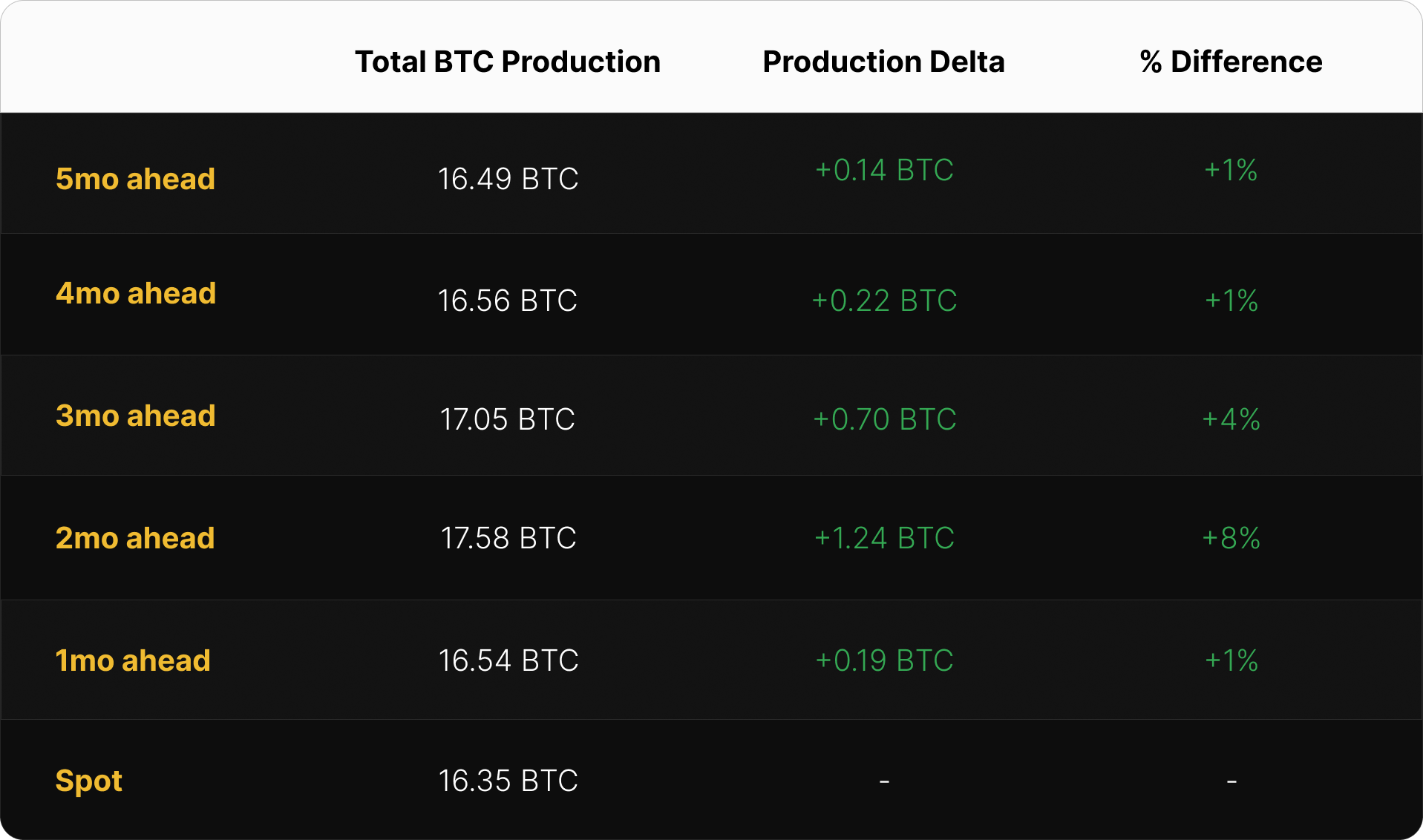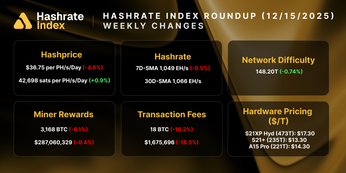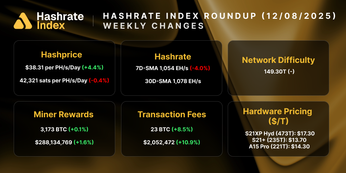
Luxor Hashrate Lookback Series - May 2025
May 2025’s hashrate and hashprice trends, forward market participation, trading activity and contract performance.
Luxor’s Monthly Lookback Series is a deep dive into Bitcoin hashrate market activity. In this post, we cover May 2025’s hashrate market and hashprice trends, forward market participation, trading activity and contract performance.
Summary
- Hashprice Heats Up: USD hashprice jumped 19.9% in May as Bitcoin broke to a new all-time daily high of $111,005. BTC hashprice was flat, with difficulty and fees averaging steady month-over-month.
- Difficulty Dips, Then Rips: May saw three difficulty adjustments — a dip followed by two increases — ending with a new all-time high of 126.98T on May 30.
- Forward Markets Catch a Bid: Forward contracts told a bullish story: USD hashprice forwards rose 8–10%, BTC forwards fell 2–4%, and implied Bitcoin prices climbed 11–13% across the curve.
- Fixed Payouts Outperformance: Rolling BTC-denominated hedges continued to outperform over the past year, especially for 4–5 month durations. Upfront and fixed payouts helped miners earn more with less uncertainty.
- Volumes Go Vertical: Luxor's OTC hashrate forward market is now clearing up to 25 EH daily, with YTD notional trading volume surging past $100M and on track for several hundred million by year-end.
May 2025 Spot Hashprice & Its Constituents
After three sluggish months, mining economics improved in May. The average USD-denominated hashprice rose nearly 20% month-over-month, driven entirely by a similar increase in Bitcoin’s price. On a BTC basis, hashprice was flat, as both average network difficulty and fees remained steady.
Hashprice saw a meaningful rebound in May, but the move wasn’t linear. USD hashprice began the month at $49.57 per PH/s/day and climbed 17.5% to a peak of $58.26 on May 22 — the highest daily hashprice since February 4. It then pulled back to $52.11 by month’s end. This mid-month rally helped lift the overall monthly average, despite the late retrace.
Given the rise in USD hashprice, energy-adjusted mining revenues also increased in May. On a monthly average basis, operations with sub-19 J/TH fleets earned approximately $134 per MWh. Miners in the 19–25 J/TH and 25–38 J/TH efficiency tiers earned around $103 and $71 per MWh, respectively.
Bitcoin price was the main driver of USD hashprice gains in May. It opened the month just below $96,000, climbed to a new all-time high of $111,005 on May 22, and closed the month at $104,123. This 16% intra-month increase — and new record high in USD terms — was the primary factor behind stronger mining economics, as average difficulty and fees remained mostly unchanged month-over-month.
While average network difficulty was flat month-over-month, intra-month adjustments told a more nuanced story. The network saw three network difficulty changes in May: a -3.34% drop on May 3, followed by increases of +2.13% on May 17 and +4.38% on May 30. Difficulty started the month at 123.23T, dipped to 119.12T mid-month, then climbed steadily to finish at 126.98T, setting a new all-time high.
The transaction fee bear market continued through May, with low congestion and minimal on-chain activity for most of the month. The only notable spikes came on May 12 and 16, when fees briefly rose to ~9 sats/vbyte. These were driven by the emergence of a new metaprotocol called Alkanes, which has gained traction in China and spurred minting activity.
With transaction fees muted for most of the month, BTC-denominated hashprice largely reflected network difficulty adjustments. It began May at 0.00052 BTC/PH/day, edged up to 0.00054 on May 13 following the early-month difficulty drop and mid-month fee activity, and then gradually declined to end the month at 0.00050 — its lowest daily value of the month.

May 2025 Hashrate Market Activity
Our analysis of the May hashrate market focuses on two key points: how the May 2025 hashrate contract traded in previous months and how the forward curve shifted in May, based on pricing for forward hashrate during the month.
The two tables below show the evolution of USD and BTC denominated Bitcoin hashrate forward markets from December 2024 - May 2025. Rows represent specific monthly contracts, while columns represent each trading month. Cell values indicate the average monthly mid-market price — except for the bold highlighted main diagonal — which shows actual spot hashprice settlement in each month.
This table summarizes both the trading history of the May 2025 contract (colored row) and the forward curve in May (colored column).
Note: all values shown in figures represent the midpoint of the best bid and ask on Luxor's Non-Deliverable Hashprice Forward market.
The table below shows the type of market participants on the buy and sell side of Luxor’s deliverable (DF) and non-deliverable hashrate forward (NDF) market. In May, lenders were active on the buy side of the DF market, while public and private miners used the contract to sell forward, receive financing, and expand their fleet.

Since the DF involves upfront payment, it tends to trade at a discount to the NDF (compensating the buyer for the inherent credit risk). We see the discount of DF’s relative to NDF’s as the interest rate in hashrate-based lending markets. Buyers and sellers of the DF with upfront payment can use the NDF to lock-in a fixed yield or cost of capital instead of having exposure to hashprice uncertainty.
This strategy was used by lenders (i.e., buy the DF & sell the NDF) to earn a return and by miners (i.e., sell the DF & buy the NDF) to obtain non-dilutive financing. In May 2025, that yield or cost of capital was in the 8-13% (annualized) range.
How May 2025 Hashrate Traded
In USD terms, the May 2025 contract was a mixed bag. Sellers who hedged early — in December or January — outperformed spot FPPS payouts, locking in higher fixed prices before the multi-month hashprice slump. But as the bear market reversed in May, buyers who entered later — in February, March, or April — ended up profiting from the recovery, with spot revenues finishing above their fixed hashcosts.
On the BTC-settled side, sellers came out ahead across the board. Forward sales in December, January, and April narrowly beat spot FPPS by about 1%, while earlier hedges in February and March earned stronger gains of ~4% and ~8%, respectively.
The tables below summarize how a 1 EH mining operation would have performed by selling May 2025 hashrate forward — one showing USD revenue outcomes, the other showing total bitcoin production — compared to spot mining via FPPS.


Zooming out, the following chart reveals how different rolling hedge strategies performed relative to spot mining, segmented by contract denomination and hedge horizon over the last twelve months, from June 2024 – May 2025:
This comparison clearly shows that rolling BTC-denominated hedging strategies outperformed between June 2024 and May 2025, with the strongest results coming from 4- and 5-month forward sales. These longer-duration contracts were typically priced ahead of rising network difficulty and low fee environments, while still preserving Bitcoin price exposure. In contrast, USD-denominated hedging underperformed spot FPPS by an average of 0.5%.
Miners who locked in fixed payouts were better insulated from the hashprice decline driven by difficulty increases and weak fee activity. Those who used upfront payout structures saw further benefits by front-loading revenue. With hardware costs rising and margins tightening, securing predictable cash flows through forward sales helped reduce exposure to volatile market conditions.
Note: these figures are strictly for demonstration purposes and exclude fees and bid/ask spreads associated with entering into hashrate forward contracts.
A second caveat: although selling forward proved to be favorable during timeframes shown above, it is critical to recognize that hedging is typically a cost of business rather than a revenue generation method. Hedgers willingly pay a price to buy certainty and obtain more predictable cash flows, which increases valuation, reduces cost of capital, and ultimately attracts investments.
Case in point, Luxor’s hashrate forward marketplace is now settling up to 25 EH daily, with over $100M in notional volume traded year-to-date (YTD) already and on pace for several hundred million this year.
How Future Hashrate Traded in May 2025
The two tables below summarize the evolution of hashrate forward markets during May 2025, for the subsequent five months from June 2025 - October 2025. Rows represent specific monthly hashrate contracts, while columns represent specific trading days. Cell values indicate the average daily mid-market price, except for spot prices.
Between May 5 and June 2, June to October USD-denominated hashrate contracts rose 8–10% as Bitcoin price strengthened and spot hashprice recovered. In contrast, BTC-settled contracts declined by 2–4%, reflecting the falling BTC spot hashprice trend. Most monthly contracts traded in backwardation throughout the period, though June and July began pricing more evenly as the market looked ahead to the summer 4CP season in Texas.
By dividing USD contract values with BTC contract values, we can use the two contracts to back out implied Bitcoin price expectations expressed by the forward market. Throughout May, implied Bitcoin price expectations rose steadily, mirroring the rally in spot markets and indicating renewed bullish sentiment for the near future.
BTC forward prices mostly traded in contango, with a brief dip into backwardation mid-month as spot prices surged. From May 5 to June 2, forward months rose between 11–13%, reflecting the market’s upward revision of near-term price expectations.
If we make an assumption around transaction fees, we can also calculate the changes in implied difficulty and network hashrate expectations expressed by the forward market. In the tables below, we assume a 0.04 BTC and 0.03 BTC per block transaction fee collection on May 5th and June 2nd, respectively:
Note: figures assume 0.04 BTC and 0.03 BTC per block transaction fee collection on May 5th and June 2nd, 2025.
Based on this simplified analysis, we estimate that future hashrate expectations rose during the month of May, rising in the 2-4% range for the June 2025 - October 2025 contracts.
Concluding Thoughts and Looking Ahead
As noted in last month’s Lookback, June marks the beginning of ERCOT’s Four Coincidence Peaks (4CP) program — a seasonal feature of the Texas power market that heavily influences mining behavior. 4CP measures a large industrial customer’s demand during the grid’s four highest-load hours across June, July, August, and September. These hours are typically in the late afternoon on the hottest weekdays. The higher a customer’s demand during those intervals, the more they pay in transmission charges the following year. As a result, many large miners in ERCOT reduce or curtail load during potential 4CP hours to minimize future costs.
The impact of this behavior is already visible in the latest difficulty epoch. Since May 30’s difficulty adjustment, we’re projecting a negative -1% to -2% adjustment for June 13 — a sign that aggregate network hashrate is slightly down. Early June block time data supports this: during likely 4CP hours, blocks have averaged roughly 88 seconds slower than during non-4CP periods (as of June 10, 2025 UTC 16:00). However, it’s important to note that not all of this slowdown is attributable solely to the 4CP strategy. These same hours tend to coincide with higher power prices, which can independently incentivize curtailment even outside of the 4CP calculation.
If you are interested in learning more about mining and energy, check out our recently launched series: Energy Markets for Bitcoin Miners.
In the next few posts for this series, we’ll explore advanced strategies miners are using to deepen their exposure to power markets — and how to create value beyond producing Bitcoin.
Looking forward, Luxor’s Hashrate Forward Market is pricing in an average hashprice of $54.34 or 0.00049 BTC per PH/s/day over the next six months. Sellers can currently secure this hashprice while buyers have the opportunity to lock in the same hashcost through to October 2025.
If you’d like to learn more about Luxor’s Bitcoin mining derivatives, please reach out to [email protected] or visit https://www.luxor.tech/derivatives.
Disclaimer
This content is for informational purposes only, you should not construe any such information or other material as legal, investment, financial, or other advice. Nothing contained in our content constitutes a solicitation, recommendation, endorsement, or offer by Luxor or any of Luxor’s employees to buy or sell any derivatives or other financial instruments in this or in any other jurisdiction in which such solicitation or offer would be unlawful under the derivatives laws of such jurisdiction.
There are risks associated with trading derivatives. Trading in derivatives involves risk of loss, loss of principal is possible.
Hashrate Index Newsletter
Join the newsletter to receive the latest updates in your inbox.








